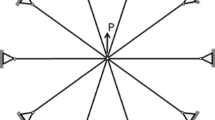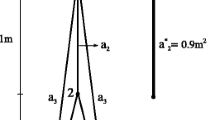Abstract
This paper discusses ground structure approaches for topology optimization of trusses. These topology optimization methods select an optimal subset of bars from the set of all possible bars defined on a discrete grid. The objectives used are based either on minimum compliance or on minimum volume. Advantages and disadvantages are discussed and it is shown that constraints exist where the formulations become equivalent. The incorporation of stability constraints (buckling) into topology design is important. The influence of buckling on the optimal layout is demonstrated by a bridge design example. A second example shows the applicability of truss topology optimization to a real engineering stiffened membrane problem.
Similar content being viewed by others
References
Achtziger, W. 1993: Optimierung von einfach und mehrfach belasteten Stabwerken.Bayreuther Mathematische Schriften,46, Dissertation
Achtziger, W. 1995: Truss topology optimization including bar properties different for tension and compression.Struct. Opt. (to appear)
Achtziger, W.; Bendsøe, M.P.; Ben-Tal, A.; Zowe, J. 1992: Equivalent displacement based formulations for maximum strength truss topology design.Impact Comp. Sci. Eng. 4, 315–345
Barta, J. 1957: On minimum weight of certain redundant structures.Acta. Techn. Acad. Sci. Hung. 18, 67–76
Beckers, M.; Fleury, C. 1994: A primal-dual approach in truss topology optimization. LTAS,Structures Aérospatiales, Universite de Liège, Rapport OA-34
Bendsøe, M.P. 1995:Methods for optimization of structural topology, shape and material. Berlin, Heidelberg, New York: Springer
Bendsøe, M.P.; Ben-Tal, A.; Zowe, J. 1994: Optimization methods for truss geometry and topology design.Struct. Optim. 7, 141–159
Cox, H.L. 1965:The design of structures for least weight. Oxford: Pergamon
Dorn, W.S.; Gomory, R.E.; Greenberg, H.J. 1964: Automatic design of optimal structures.Journal de Mécanique 3, 25–52
Fleron, P. 1964: The minimum weight of trusses.Bygnings statiske Meddelelser.35, 81–96
Gerdes, D. 1994: Strukturoptimierung unter Anwendung der Optimalitätskriterien auf diskretisierte Fachwerke bei besonderer Berücksichtigung der Stabilität. Doctoral Thesis, FB 10, Essen University; also: VDI Verlag, Reihe 18, Nr. 171
Hemp, W.S. 1973:Optimum Structures. Clarendon Press, Oxford, UK
Hörnlein, H.R.E.M. 1979: Ein Algorithmus zur Strukturoptimierung von Fachwerkkonstruktionen, DiplomarbeitLudwigs-Maximilian-Universität, München
Hörnlein, H.R.E.M. 1994: Topologieoptimierung von Stabstrukturen, VDI/WLZ-Seminar 32-63-08, RWTH, Aachen
Jarre, F.; Kočvara, M.; Zowe, J., 1995: Interior point methods for mechanical design problems. Technical Report.The Institute of Statistical Mathematics, Tokyo, Japan
Klarbring, A.; Petersson, J.; Rönnqvist, M. 1995: Truss topology optimization involving unilateral contact.Journal of Optimization Theory and Applications.87 (1)
Michell, A.G.M. 1904: The limits of economy of material in frame structures.Philosophical Magazine 8, 589–597
Pedersen, P. 1993: Topology optimization of three-dimensional trusses. In: Bendsøe, M.P.; Soares, C.A.Topology Design of Structures. pp. 19–30. Dordrecht: Kluwer
Rozvany, G.I.N.; Bendsøe, M.P.; Kirsch, U. 1995: Layout optimization of structures. ASME Reprint No AMR159,Appl. Mech. Rev. 48
Sved, S. 1954: The minimum weight of certain redundant structures.Australian Journal of Applied Science 5, 1–9
Taylor, J.E.; Rossow, M.P. 1977: Optimal truss design based on an algorithm using optimality criteria.Int. J. Solids Struct. 13, 913–923
Zhou, M.; Rozvany, G.I.N. 1992, 1993: DCOC: an optimality criteria method for large systems. Part I: theory. Part II: algorithms.Struct. Optim. 5, 12–25;6, 250–262
Zotemantel, R. 1993: MBB-Lagrange: A computer aided structural design system. In: Hörnlein, H.; Schittkowski, K. (eds.)Software Systems for Structural Optimization, pp. 143–158. Basel, Boston, Berlin: Birkhäuser
Author information
Authors and Affiliations
Rights and permissions
About this article
Cite this article
Oberndorfer, J.M., Achtziger, W. & Hörnlein, H.R.E.M. Two approaches for truss topology optimization: a comparison for practical use. Structural Optimization 11, 137–144 (1996). https://doi.org/10.1007/BF01197027
Received:
Revised:
Issue Date:
DOI: https://doi.org/10.1007/BF01197027




